In the exhibit,
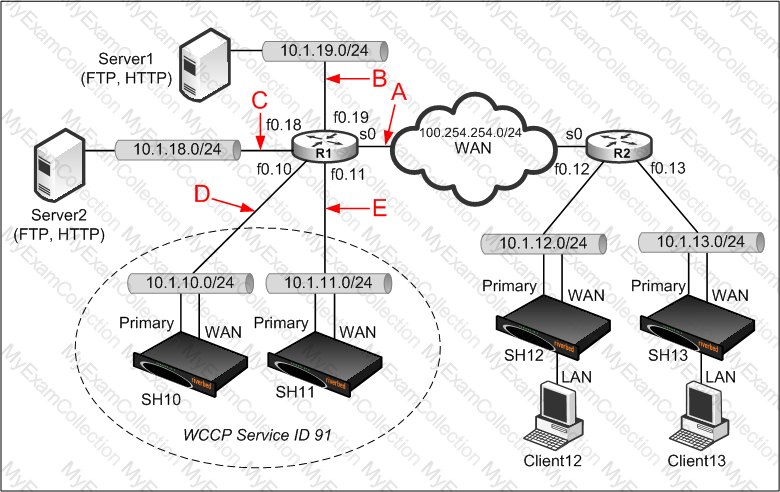
where should the WCCP redirection take place for server return traffic, assuming redirect IN is used? (Select 2)
The Interceptor appliance cluster can support how many optimized connections?
A deployment has two parallel Interceptor appliances (A and B) each across a different link directed at different data center locations. Each data center has one Steelhead appliance (Steelhead-1 or Steelhead-2). The administrator wants probes coming into Interceptor A to be first serviced by Steelhead-1, then Steelhead-2 only if Steelhead-1 is full or unavailable. What is the most appropriate rule to be configured?
What is the default behavior of an Interceptor appliance using 2.0 code when its peer Interceptor appliance is unavailable?
Which of the following are configurable attributes of an Interceptor appliance? (Select 3)
The Interceptor appliance will attempt to redirect a connection to a Steelhead appliance in the auto pool:
What happens to traffic when a Steelhead appliance reports admission control?
What service needs to be allowed if you are enforcing outbound security in the Steelhead Mobile solution?
You would like your Steelhead Mobile clients to automatically detect when they are in a branch office with a local Steelhead. You have decided that the Steelhead Mobile Client should only optimize connections if the Steelhead appliance is more than 10 ms away. What is the name of the feature you need to enable?
The amount of memory required for Steelhead Mobile installation varies between 81 MB to 228 MB. What is the reasons for the variation?
The Steelhead Mobile client on your laptop is showing a status of “Firewalledâ€. What is the problem?
What information is available in the System Snapshot files on the Steelhead Mobile Controller?
What are the possible ways to downgrade a Virtual Steelhead appliance after it has been upgraded?
What is the primary purpose of enabling Multiple Interface Support on the Interceptor?
The SteelHead Out of Band splice (OOB) uses which addressing mode? Assume a default configuration.
A SteelHead blocks all traffic when the appliance is powered off. What reasons could cause this behavior? (Choose two.)
-- Exhibit –
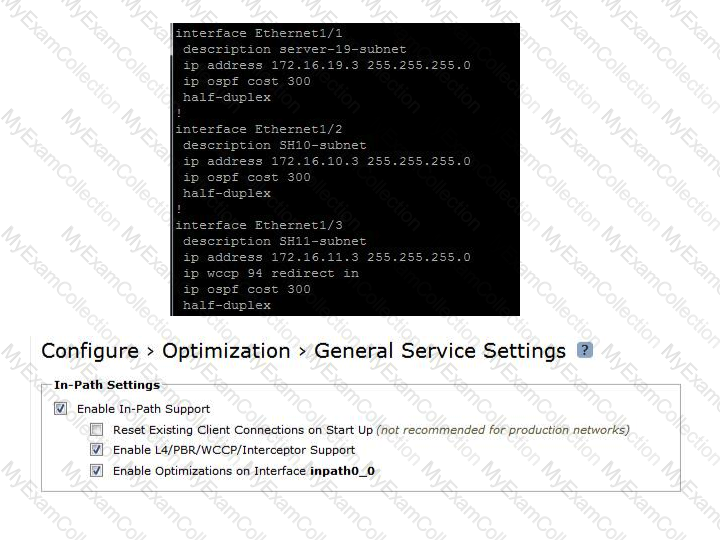
-- Exhibit --
Refer to the exhibit. In a WCCP environment with R3, SH10 and SH11, it was observed that the returning traffic from Server2 is not being optimized by the Steelhead appliances. Why? (Select 2)
-- Exhibit –
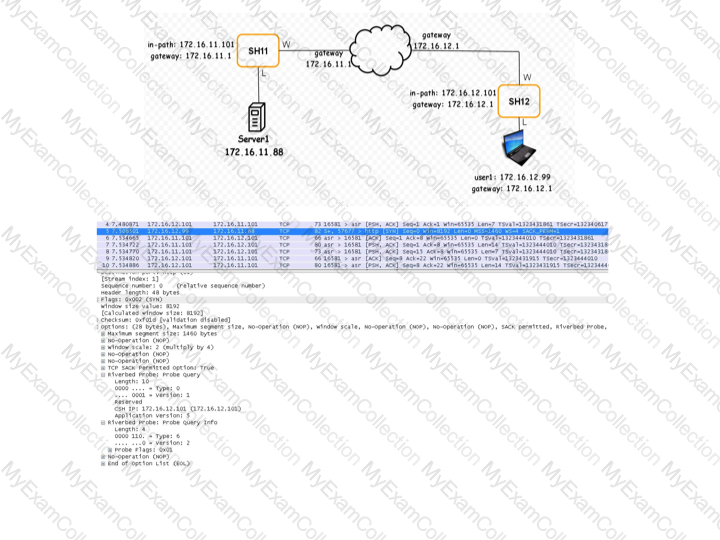
-- Exhibit --
Refer to the exhibit. According to the packet capture, what statements are true? (Select 2)
-- Exhibit –
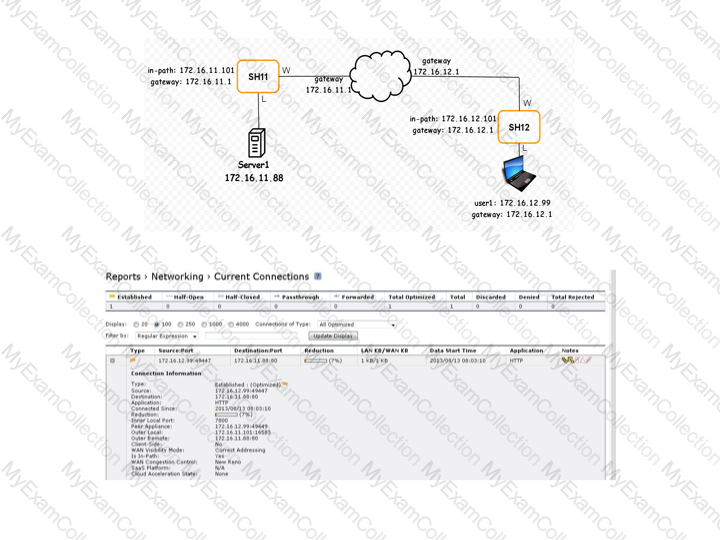
-- Exhibit --
Refer to the exhibit. What statements are true? (Select 2)
Citrix remote applications, running on the server and to access printers and disk drives, are not performing well. What can you configure to improve the performance?
What type of problem does the error message below indicate:
Sep 7 22:53:50 SH pm[18184]: [pm.NOTICE]: Output from sport:
/opt/rbt/bin/sport (pid 27529) received signal 12 (SIGUSR2) marking bit
You plan to downgrade a SteelHead from RiOS v9.0.1 (Apr 17 2015) to 8.6.3 (Aug 7 2015). The appliance has not run v8.6.3 previously. Will this be successful?
A SteelHead is deployed in a VLAN bridge. Which VLAN ID should be configured on the in-path interface to support this environment?
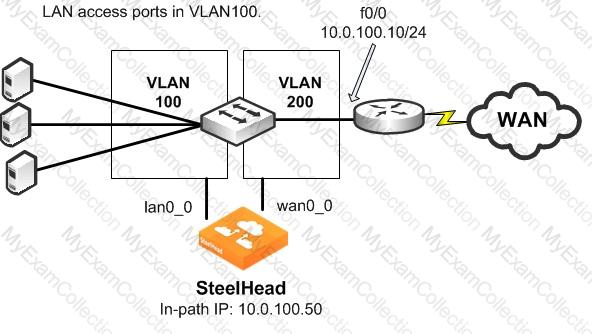
Consider a SteelHead deployment with SMB optimization and SMB signing enabled on all SteelHeads. The client is configured to have signing enabled and the server has signing disabled. What will happen to SMB connections between these two hosts?
What type of problem does the error message below indicate:
Aug 30 18:19:27 SH pm[18716]: [pm.ERR]: Output from sport:
/opt/rbt/bin/sport (pid 11304) received signal 6 (SIGABRT) dumping core
SteelHead SaaS is configured using the default redirection port. Which statement correctly describes the configuration that must be applied to a firewall at the branch location?
At the data center, two SteelHeads are deployed in parallel, configured with connection forwarding. They are both actively optimizing connections via inpath0_0 and the customer requires that optimization continues in the event of an appliance failure. Which features should be configured to provide the customer with optimization if an appliance fails? (Choose two.)
You wish to utilize a SteelHead to fill a high bandwidth, high latency WAN link without data reduction. The link is 622mbps and 500ms latency. What steps should you take to fill the pipe?
A fat pipe is a network that can carry large amounts of data without significantly degrading transmission speed. If you have a fat pipe that is not being fully utilized and you are experiencing WAN congestion, latency, and packet loss as a result of the limitations of regular TCP, which of the following RiOS features will help? (Select 2)
The exhibit shows a data center side serial clustering deployment. In this organization, not every remote site has a Steelhead appliance deployed, and all remote locations will be connecting to the data center.
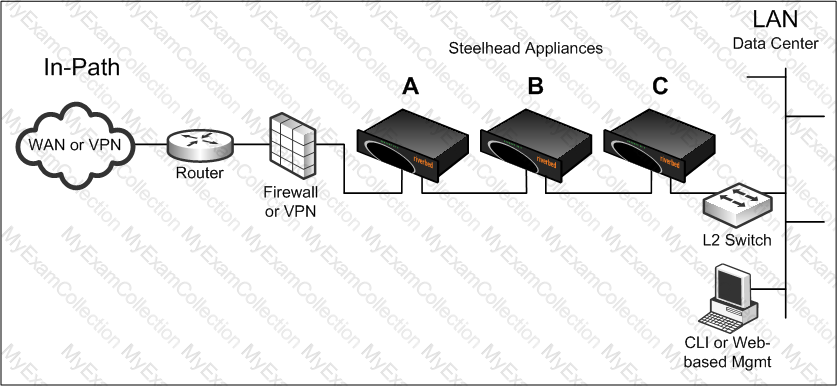
For connections initiated from the data center, there is a possibility that the Steelhead appliances shown in the exhibit will end up peering with each other, rather than the intended remote Steelhead appliances. Where are peering rules needed to prevent this problem?
Which of the following configuration policies are supported on the CMC appliance? (Select 4)
What Steelhead appliance models support the installation of Microsoft Windows Server 2008 R2 package on the RSP? (Select 2)
When upgrading a Steelhead appliance from the CMC appliance what methodologies can be used? (Select 2)
Which are true about the Steelhead appliance backups taken and stored by the CMC appliance? (Select 3)
In a server-side out-of-path deployment, the server-side Steelhead appliance connects to the network via which physical interface:
Refer to the exhibit.
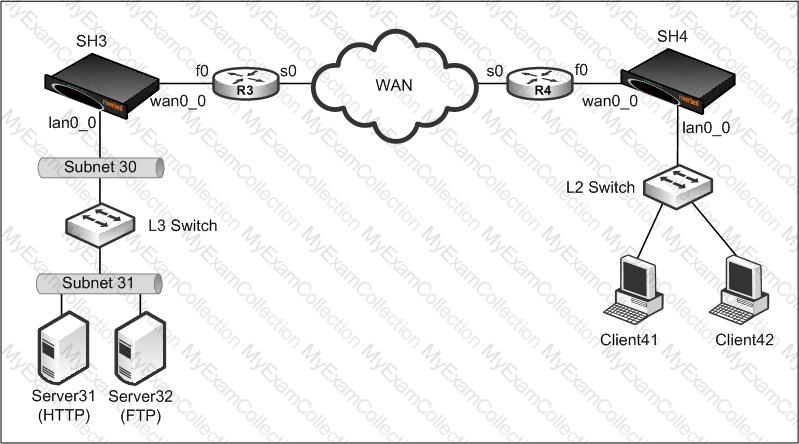
A connection times out when Client41 and Client42 attempt to either establish an HTTP session to Server31 or an FTP connection to Server32 after not connecting to them for some time. The very next attempt to connect to these services done immediately after the failure seems to work correctly. The clients are able to ping both servers and no access-lists are configured on the routers. SH3 uses the IP address of R3f0 as its default gateway. Upon powering off SH3 and SH4, the problem goes away even for first connection and everything works normally (even after not connecting for extended periods of time). Which of the following are likely to correct this problem?
Your Steelhead appliance deployment includes users accessing the Internet from branch offices with the traffic being back-hauled to the data center before going out to the Internet. However, HTTP latency optimization does not appear to be very effective, and in certain cases, is slower than without optimization. What settings might help with this Internet-bound traffic?
When using TACACS+ or RADIUS to authenticate management access to the CMC appliance, which of the following is true?
What is the primary purpose of Connection Forwarding in WCCP deployments with multiple Steelhead appliances in a single cluster? (Select 2)
When two or more Steelhead appliances are configured with Connection Forwarding in such environments as WCCP clustering, what feature will allow remaining Steelhead appliances to continue to provide optimization for new connections when one unit fails?
To prevent possible denial of service attack, such as TCP SYN flooding, which of the following features could be used?
When using Correct Addressing, what is the out-of-band (OOB) splice connection described as?
You are configuring HighSpeed TCP in an environment with an OC-3 (155Mb/s) and 60 milliseconds of round-trip latency. You know that the rule of thumb is to set the Steelhead appliance's WAN Default Send Buffer Size and WAN Default Receive Buffer Size to 2*BDP for the link. The buffer size setting for this link would be closest to: (Hint: Use the calculator)
Which of the following methods can be used to reduce the load on a router configured to use outbound interface WCCP redirection? (Select 3)
The IP address for which neighbor interface should be configured for Connection Forwarding?
1) lan0_0
2) inpath0_0
3) Primary
4) AUX
5) inpath7_7
Which of the following interfaces should be used for datastore synchronization? (Select 2)
-- Exhibit –
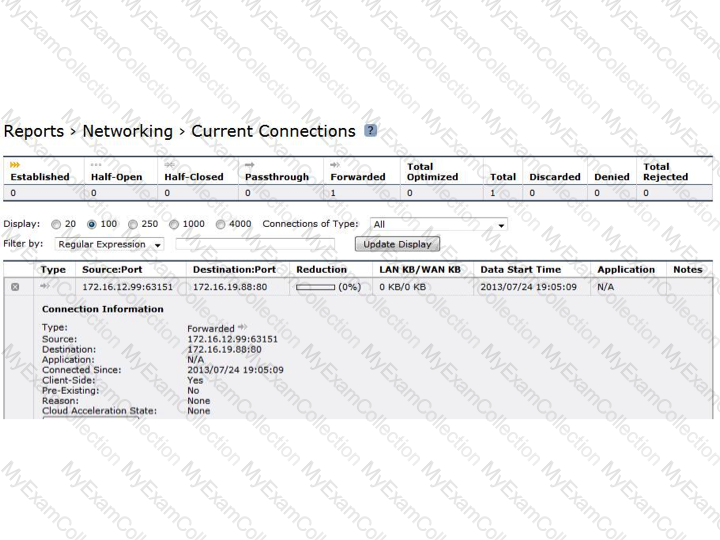
-- Exhibit --
Refer to the exhibit. The connection from USER1, going to SERVER2 is not being optimized by SH10. What is the possible cause? (Select 2)

